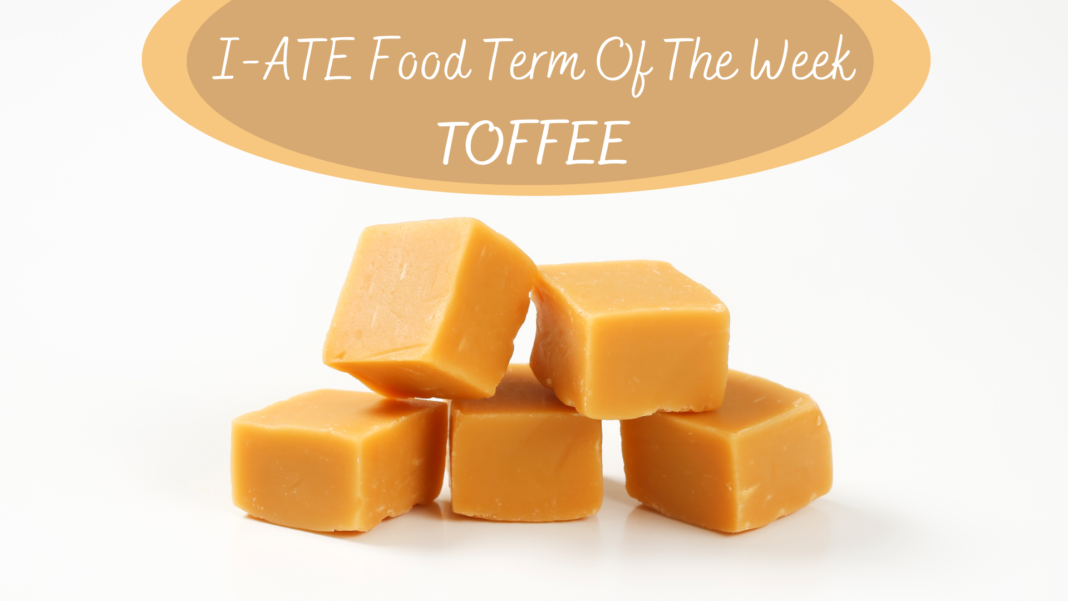Toffee is one of the UK’s most famous candies and maintains its extreme popularity for its unique flavour and regional variations. Although it is often compared to caramel, it must not be confused with it: while caramel is made out of out of sugar, water, and cream or milk, Toffee is only made out of sugar and butter. Sugar is then heated until caramelised, and then allowed to cool and set. It can be chewy or crunchy, stretchy or crystalline, depending on its degree of caramelising. Although it is a very simple sweet, Toffee needs very specific environmental conditions. It is indeed temperamental and can be affected by temperature, altitude, and humidity. But let’s go back to Toffee’s origins, when it was just a relatively simple hard candy.
HISTORY OF TOFFEE
Called Taffy in the USA, Toffee firstly appeared in English dictionaries in 1825, more precisely in the Oxford English dictionary, and most food historians agree that it probably originated in Wales and then spread across Britain and Europe, where there were plenty of supplies of butter and imported sugar. The word is believed to come from ‘tafia’, a West Indian rum made with molasses or sugarcane juice. Most likely, although the term became a dictionary entry in the early 19th century, it existed long before. However, other theories claim that it developed a bit later, when slavery led to a steep drop in the prices of both sugar and molasses, which meant that the key ingredients necessary to make toffee were plentiful and easily accessible. Therefore, English female workers of the time created this delicious and affordable candy.
HOW IT CAN BE USED
Toffee nowadays serves as one of the main ingredients for more elaborated cookies, pastries, puddings and cakes. It can also be combined with many other sweet ingredients, such as wrappings of chocolate, almonds and nuts, resulting in larger delicious sweet treats. Typical examples of Toffee-based recipes are the famous Toffee Apples, Pralines and Bonfire Toffee. It can also be prepared as a savoury sauce to be added as a topping on other sweets and cakes. Long story short, it can be used in many different modalities, and experimenting new recipes is what makes it fun!


References:
Cache Toffee. 2022. History of English Toffee – Cache Toffee Collection. [ONLINE] Available at: https://cachetoffee.com/history-of-english-toffee/#:~:text=Toffee%20didn%27t%20appear%20in,eventually%20imported%20sugar%20were%20plentiful.. [Accessed 28 July 2022].
Spoon University. 2022. Caramel vs Toffee: What is the Difference?. [ONLINE] Available at: https://spoonuniversity.com/lifestyle/caramel-vs-toffee-what-is-the-difference#:~:text=Caramel%20is%20made%20out%20of,%22hard%20crack%22%20stage).. [Accessed 28 July 2022].
Woody Candy Company. 2022. The History of Toffee : Woody Candy Company. [ONLINE] Available at: https://woodycandy.com/english-butter-toffee/?v=e71bc9c013d9. [Accessed 28 July 2022].

Written by Toffee Eleni Vanelli
Born in Cyprus in 1997 and living in Italy since 2002, Toffee’s bi-cultural background has determined the development of her interest in the world’s linguistic and cultural differences, which she enhanced by choosing a linguistic-based career path. She holds a Bachelor’s degree in Cultural Mediation (University of Udine) and a Master’s degree in Modern Languages for Communication and International Cooperation (University of Padua); she fluently speaks Italian, English and French, and she also knows Greek, German and Spanish. Toffee has engaged in Specialized Translation and Terminology. Especially during her Master’s degree, she has deepened her knowledge, competences and interests in the world of Terminology and the European Union law. She participated in numerous (inter)national Translation and Terminology projects, such as the European Terminology without Borders project in 2020 and 2021.

